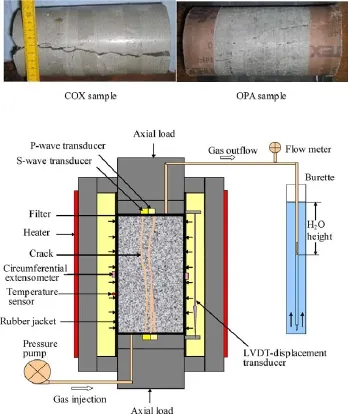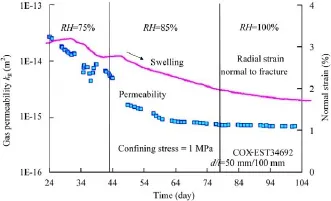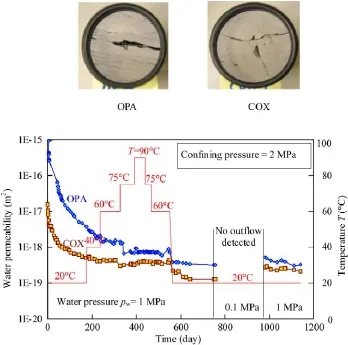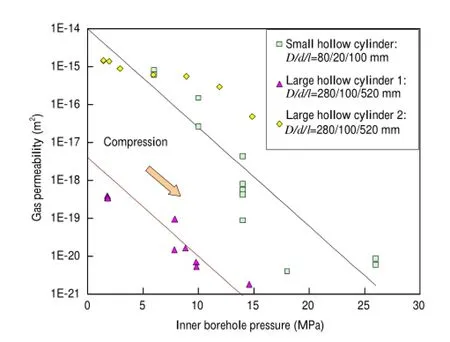Sealing of fractures in claystone
Chun-Liang Zhang
Gesellschaft für Anlagen- und Reaktorsicherheit (GRS), P.O. Box 38122, Braunschweig, Germany
Sealing of fractures in claystone
Chun-Liang Zhang∗
Gesellschaft für Anlagen- und Reaktorsicherheit (GRS), P.O. Box 38122, Braunschweig, Germany
ARTICLE INFO
Article history:
Received 26 March 2013
Received in revised form 11 April 2013
Accepted 20 April 2013
Clay rock
Damage
Fracture closure
Permeability
Sealing experiment
Nuclear waste repository
The sealing behavior of fractures in clay rocks for deep disposal of radioactive waste has been comprehensively investigated at the GRS laboratory. Various sealing experiments were performed on strongly cracked samples of different sizes from the Callovo-Oxfordian argillite and the Opalinus clay under relevant repository conditions. The fractured samples were compacted and flowed through with gas or synthetic pore-water under confining stresses up to 18 MPa and elevated temperatures from 20°C to 90°C. Sealing of fractures was quantified by measurements of their closure and permeability. Under the applied thermo-hydro-mechanical (THM) conditions, significant fracture closure and permeability decrease to very low levels of 10−19to 10−21m2were observed within time periods of months to years. The properties of the resealed claystones are comparable with those of the intact rock mass. All test results suggest high sealing potentials of the studied claystones.
© 2013 Institute of Rock and Soil Mechanics, Chinese Academy of Sciences. Production and hosting by Elsevier B.V. All rights reserved.
1. Introduction
Excavation of an underground repository for deep disposal of radioactive waste in an argillaceous formation generates fractures around the openings and may induce pathways for fluid transport and radionuclides migration. Because of the favorable properties of claystone such as the rheological deformability and swelling capability, a recovery process of the excavation damaged zone (EDZ) can be expected due to the combined impact of the progressive deformation of the clay host rock, the increasing resistance of the engineered barriers (buffer, backfill and seals), and the swelling of clay minerals into fracture interstices during the post-closure phase. For the assessment of the long-term safety of a repository, various kinds of evidence, deep understanding, precise characterization, and reliable prediction of the sealing process of the EDZ are indispensable.
Within the last decade, the sealing behavior of fractures in claystones has been comprehensively investigated at the GRSgeotechnical laboratory on the Callovo-Oxfordian argillite (COX) in France and the Opalinus clay (OPA) in Switzerland (Zhang and Rothfuchs, 2008; Zhang et al., 2008, 2010a,b; Zhang, 2009, 2011). Both clay formations are being investigated as the potential host rocks for the disposal of radioactive waste. According to the French and Swiss disposal concepts (Nagra, 2002; ANDRA, 2005), the potential repositories will be located in the clay formations at depths of about 500 m and 650 m below the ground surface, respectively. The corresponding lithostatic stress is in a range of 12–18 MPa. The designed thermal load from high-level radioactive waste (HLW) is limited to 90°C in the host rocks. The repository openings will be backfilled and sealed with suitable materials to stabilize the integrity of the natural and engineered barriers and to prevent release of radionuclides into the biosphere. When the formation water migrates in the EDZ, possible chemical reactions may result between pore-water, solutes, and fracture surfaces. Complex thermo-hydro-mechano-chemical (THMC) pro
cesses are to be expected in the natural and engineered barriers for long periods of time (tens of thousands years). In consideration of the relevant repository conditions, various kinds of laboratory experiments were designed and performed on fractured samples to characterize the sealing behavior of damaged claystones under combined mechanical compression, water/gas flow, and thermal loading. Fracture closure and permeability changes were determined over long testing durations of months to years. The most important results are presented and discussed in this paper.
2. Sample characterization

Fig. 1. Pictures of fractured samples and principle of a sealing test in triaxial cell.
Core samples were taken from the COX at the Underground Research Laboratory (URL) at Bure in France and from the OPA at the Mont Terri URL in Switzerland. On an average, the COX argillite contains 25%–55% clay minerals, 20%–38% carbonates, 20%–30% quartz, and small amounts of others (ANDRA, 2005), while the OPA contains higher clay contents of 58%–76%, less carbonates of 6%–24% and quartz of 5%–28% (Pearson et al., 2003). The clay rocks have been overconsolidated through specific geological histories over hundreds of millions of years to low porosities of 14–18% and low permeabilities of 10−20to 10−21m2.
The samples were prepared to cylinders of different sizes in diameter/length (d/l) = 50 mm/50 mm to 280 mm/500 mm. The normally sized samples (d/l ≤ 100 mm/200 mm) were artificially cracked along the length nearly parallel to bedding planes and tested to characterize the sealing behavior of fractures. The large samples of d/l = 280 mm/500 mm were prepared to hollow cylinders with axially drilled boreholes of 100 mm diameter to investigate fracturing and sealing processes of the clay rock around boreholes by simulation of the borehole excavation, backfill support, water/gas migration, heating and cooling due to heat emission from HLW.
3. Sealing of fractures by compression
The EDZ will be gradually compressed by the progressive rock deformation and the increasing resistance of the engineered barriers during the repository post-closure phase. The response of the damaged claystone to the mechanical compression was studied on pre-fractured samples under various loading conditions.
Fig. 1 shows pictures of fractured COX and OPA samples (d/l = 100 mm/200 mm) and the layout of the triaxial compression tests. The samples were isolated in jackets and compacted by increasing axial and radial stresses. Closure of fractures parallel to the sample axis was measured by a circumferential extensometer mounted at the sample mid-height. Additionally, fracture closure was also detected by monitoring changes in wave velocity using an ultrasonic device. Changes in permeability to gas along the fractures were measured by injecting nitrogen gas to the sample bottom and by recording the outflow at the opposite side.

Fig. 2. Fracture closure–normal stress relationship obtained on COX claystone.
The data of fracture closure (Δb) obtained on some COX samples under hydrostatic loads are presented in Fig. 2, as a function of the normal stress (σn). All the σn–Δb curves express the nonlinear behavior, involving the hysteresis cycle by loading/unloading and the permanent plastic deformation. Fracture closure evolves faster at large apertures in the initial loading stage and then closure rates decrease with increasing fracture stiffness at reduced apertures. The relationship of fracture closure with normal stress can be approached by an exponential equation (Zhang, 2011):

where bmis the possible maximum aperture closure (equal to the initial aperture), α and β are constants. If the stress tends to infinity, σn→ ∞, the fractures will be fully closed, Δb → bmand b → 0. Fitting the data leads to a unique set of parameters α = 0.3 and β = 0.5 for the samples with different initial apertures of bm= 0.38–2.30 mm. A reasonable agreement between the model and the data is achieved.
The closure of fractures is related to the intrinsic permeability in the fractured clay rock. The permeability variation with fracture aperture may be approached by the “cubic law” for a set of parallel fractures of equal aperture which are oriented parallel to flow direction. The permeability of a fractured rock is contributed by the fracture conductivity (Kf) and also by that of the porous matrix (Km) (Zhang, 2011):

where bcdenotes a critical aperture, b is the average fracture aperture, and F represents an integrated character of the set of fractures.
The low permeability of Km= 1 × 10−21m2is accepted for the intact rock mass. Fig. 3 compares the cubic model by application of various F-values with the measured permeability data as function of the fracture aperture decreased by loading. Whereas the parameter F differs from one sample to another due to the different fracture features, a unique critical aperture bc= 0.02 mm seems to be adequate for all the samples. As the geometric fracture aperture b decreases to a very low magnitude, b ≤ bc, the network of the fractures tends to be disconnected and the hydraulic conductivity in the dead-end fractures is ineffective.

Fig. 3. Fracture permeability–aperture relationship obtained on COX claystone Km= 10−21m2.
Fig. 4 compares the permeability data obtained on two fractured OPA samples with different sizes and different fracture intensities. The fractures were nearly parallel to the sample axis. Because of the different intensities of the fractures, the more strongly fractured large sample of d/l = 260 mm/600 mm (see Fig. 4) had a higher initial permeability value of 10−13m2, while Kg= 5 × 10−16m2was determined for the normally sized sample of d/l = 100 mm/200 mm with relatively small fracture openings (see Fig. 1). On both samples, the effect of normal stress on the sealing behavior of fractures is quite similar and less dependent on their scales. The increase in normal stress led to a drastic decrease in permeability down to 10−19m2at the large sample and 10−20m2at the normal sample, respectively, as the stress reached 15 MPa approximately.
In addition to the hydrostatic compression, effects of shear loading were also examined. Fig. 5 shows a test example on a COX sample (d/l = 70 mm/140 mm) in terms of measured stressaxial/radial/volumetric strain (Δσ–ε1, Δσ–ε3, εv–ε1) curves and gas permeability variation (Kg–ε1) during the prior-failure stage at lateral confining stress of σ2= σ3= 2.5 MPa and the following multiple post-failure stages at increased lateral stress up to 20 MPa. In the prior-failure stage, the deviatoric stress led to damage and shear fractures with an oblique angle of about 26°to the axial stress direction, which induced a dramatic increase in permeability from 3 × 10−18to 7 × 10−16m2at failure. The following multiple increase of the lateral confining stress and then the deviatoric load at each stage led to volumetric compaction or fracture closure and permeability reduction to 3 × 10−20m2at the last stage. No permeability increase could be found before the peak residual strength at each confining stress.

Fig. 4. Gas permeability as a function of normal stress obtained on fractured OPA samples with different sizes and fracture intensities.

Fig. 5. Prior- and post-failure behavior of COX claystone under multiple deviatoric loads.
Similar observations were also made on the other fractured COX samples which were loaded with different loading paths, e.g. isotropic loading by simultaneously increasing σ1= σ2= σ3to 25 MPa, or deviatoric loading by increasing σ1at σ2= σ3= 3–8 MPa, or at σ1/σ3= 4.5–6.5. Fig. 6 illustrates the measured permeability values as a function of the applied axial stress and the loading paths. In fact, the applied deviatoric stresses result in a force component normal to the shear fracture planes with oblique angles of 25°–50°to the axial stress direction. The normal stress dominates the fracture closure and permeability change, while the shear stress controls the relative displacement between the fracture planes and causes only insignificant fracture closure and permeability change.
4. Water-enhanced sealing of fractures
As well known, the studied claystones have high water adsorption potentials and swelling capabilities (Zhang et al., 2010a,b). They can take up great amount of water much higher than the water content in the naturally saturated and loaded state. The increase in water content results in a large volume expansion of up to 10% in unconfined conditions. The wetting-induced swelling, weakening and slaking will contribute to the sealing of fractures. This issue was examined by flowing wetted gas and synthetic pore-water through cracked samples under confining stresses.

Fig. 6. Permeability changes of fractured COX samples along various loading paths.
Fig. 7 illustrates the effect of wetted gas flow on fracture sealing. A fractured COX sample was flowed through firstly with dry gas over 24 days and then followed with wetted gas by increasing relative humidity (RH) from RH = 75% to 85% and 100% under confining stress of 1 MPa. The flow of wetted gas caused a gradual expansion in the radial direction normal to the fracture planes by about 1.5% over 2 months. This suggests high local swelling pressures acting in contacting areas between fracture walls. Actually, the clay fracture walls must expand preferably into the unstressed fracture voids than elsewhere. This makes the flow pathway narrow and the permeability decreases, as observed from 3 × 10−14to 6 × 10−16m2in case of this test.
Fig. 8 shows the combined impact of compression and water flow on the sealing of fractures in another COX sample (d/l = 50 mm/100 mm). Before water flowing, the gas permeability was determined to Kg= 2 × 10−12m2. The recorded radial strain normal to the fracture planes indicates that each load increase led to an immediate closure of the fractures. Because of the high swelling capability of the claystone, a gradual expansion of the fractured sample followed at each constant load below 10 MPa rather than a gradual closure. As mentioned above, the externally observed expansion indicates high local swelling pressures acting in contacting areas between fracture walls, where the material tends to expand more into the fracture voids. Additionally, the clay particles in the fracture walls contacting with water become weakening, slaking and filling the voids, resulting in a decrease in permeability. After stepwise increasing, the load to 13 MPa over 7 months, a very low permeability of Kw= 2 × 10−19m2was reached, which is close to that of the intact clay rock. The permanent sealing of fractures by swelling and slaking of clay minerals is clearly visible on the pictures in Fig. 8 comparing the fractures on the sample surface before and after testing. The fractures with sharp wall edges disappeared due to the wetting-effects.

Fig. 7. Effects of wetted gas flow on fracture sealing.

Fig. 8. Sealing of fractures in COX claystone during water flowing under various confining stresses.
After the emplacement of HLW in repository cells, the damaged surrounding rock will be heated up and dried. The clay minerals may change, affecting their swelling capacity and correspondingly the recovery of the heated EDZ. A series of additional tests aimed at examining the sealing capacity of pre-heated claystone. Three fractured COX samples (d/l = 50 mm/50 mm) were pre-heated up to temperatures of 50°C, 100°C and 150°C, respectively. The intensity of the fractures was different from one sample to another, as shown in Fig. 9. They were compressed at relatively low confining stresses of 2–3.5 MPa and flowed with synthetic pore-water through over more than 3 years. Before injecting the synthetic water, the gas permeability was measured at a high value of Kg= 3 × 10−12m2for all the three samples. As soon as the water was supplied, the permeability dropped quickly by five to seven orders of magnitude down to Kw= 10−17to 10−19m2, depending on the fracture intensity of each sample. As discussed above, this drastic drop in permeability is mainly attributed to the waterinduced swelling, slaking, and clogging of the fractures. At each load level, the permeability decreased gradually with time. The influence of the confining stress on the permeability variation was not significant in the testing range. Interesting is that the preheating up to 150°C did not hinder the sealing process of the fractures. Another important observation is that, after reduction of the injection pressure from 1 to 0.1 MPa (corresponding to a pressure gradient of 200 m/m), no water outflow was detected over 8 months. This means that the Darcy’s law might be not applicable for the highly resealed clay rock under certain low hydraulic gradients. The final permeability values determined after 3 years are very low at 3 × 10−20to 7 × 10−21m2, being the same as that of the intact claystone.

Fig. 9. Long-term evolution of the water permeability of fractured and pre-heated claystone under different confining stresses.
5. Thermal impact on sealing of fractures
Heat released from HLW is dissipated through the buffer and the surrounding rocks. The resulting temperature change may affect the development of the EDZ. The thermal impact was investigated by heating fractured claystone during water flow under confining stresses.
A test was performed on a cracked COX sample (d/l = 50 mm/100 mm) under an axial stress of 2.5 MPa and a radial stress of 2.0 MPa. The synthetic pore-water was introduced into the fractured sample at inlet pressure of 0.5 MPa. The sample was heated stepwise from 27°C to 40°C, 60°C, 75°C, 90°C and then cooled down to 60°C and 30°C, whereby radial strain normal to the fracture planes and water permeability in axial direction parallel to the fractures were measured. Fig. 10 shows the evolution of the normal strain and the water permeability. Each rapid temperature rise caused a fast expansion of the fractured sample. This is mainly contributed by the expansion of the pore-water because ofits much higher expansion coefficient compared with that of the solid grains. After a short-term compaction and water injection at 27°C, the fractured sample expanded steadily with time but the water permeability decreased due to the wetting effects on fracture sealing. At elevated temperature of 40°C, the dilation continued while the permeability increased slightly. Over 60°C, the swelling disappeared and the permeability varied slightly around 1 × 10−18m2. In contrast to the heating effects, cooling down to 30°C led to fracture compaction and permeability reduction down to 7 × 10−19m2.

Fig. 10. Normal strain and water permeability of fractured COX claystone during heating/cooling cycle.

Fig. 11. Long-term measurements of water permeability on fractured claystones during heating and cooling.
Fig. 11 illustrates the evolution of water permeability measured on two cracked COX and OPA samples during a heating/cooling cycle between 20°C and 90°C for more than 3 years. The temperature dependent viscosities of the synthetic water are taken for the calculation of the intrinsic permeabilities. Again, the waterenhanced sealing of fractures is evident during the first stage at 20°C. The permeability decreased from 1 × 10−15to 3 × 10−18m2at the OPA and from 1 × 10−17to 5 × 10−19m2at the COX sample, respectively. Subsequently, the permeability reduction rate, however, was less affected by the temperature increase up to 60°C. Further heating up to 90°C and also cooling down to 60°C had no or only little effect on the permeability reached before. Further cooling down to 20°C, however, induced a reduction of the permeability to 3 × 10−19and 1 × 10−19m2at both the samples. Again, under the injection pressure reduced to 0.1 MPa (equal to a pressure gradient of 200 m/m), no outflow of water could be detected over 8 months. The final water permeability values in a range from 10−18to 10−19m2are close to those of the intact rock.
Fig. 12 depicts the data of water permeability obtained after stabilization of each temperature stage. It is obvious that the water permeability of the fractured claystones decreases more or less with increasing temperature and drops down further after cooling. So an important conclusion can be drawn: thermal loading up to the maximum temperature of 90°C designed for repositories in clay rocks has no negative effects on the sealing process of fractures in the EDZ. However, because the hydraulic conductivity k depends on the structure of fractures and pores in the material and the thermally induced changes in viscosity μ and density ρ of the pore-water, the relatively constant intrinsic permeability K suggests an enhanced hydraulic conductivity during heating due to the decrease of water viscosity, according to the relationship between these parameters: k = Kρg/μ, where g is the gravity.

Fig. 12. Dependency of water permeability of fractured claystone on temperature.
6. EDZ development in large hollow claystone cylinders
In order to simulate fracturing and sealing processes in the surrounding host rock after the disposal of HLW in boreholes, a series of large-scale tests have been carried out on big hollow claystone cylinders. They were prepared to an outer diameter of 280 mm and lengths between 460 mm and 530 mm with axially drilled central boreholes of 100 mm in diameter. Fig. 13 illustrates the test layout and shows a photo of a large hollow cylinder before testing. An inflation packer allowing for a maximal pressure of 15 MPa was installed in the borehole for simulating the backfill support. Thermal loading was applied by means of an outer heater mounted around the triaxial cell. Borehole convergence was monitored by measuring changes of the oil volume in the packer. Outer radial strain was recorded by means of two circumferential extensometers. A syringe pump was connected with the inlet tube at the top to inject synthetic water into the sample. Water outflow was measured at the bottom using a burette at atmospheric pressure.

Fig. 13. Principle of large hollow cylinder tests for investigation of fracturing and sealing of the damaged zone around boreholes in clay rock.

Fig. 14. Fracturing-induced permeability changes in a large hollow cylinder of COX claystone.
The relevant processes during borehole excavation, backfilling, water transport, heating, and cooling were simulated by applying thermo-hydro-mechanical (THM) conditions to the large hollow samples. The main results are summarized as follows:
The borehole excavation was simulated by reducing the borehole pressure from a rock stress of 15 MPa down to 1 MPa. Consequently, no increase but a slight decrease in permeability was observed (see Fig. 14). This means that no interconnected pathways had been developed along the sample length of half a meter. This observation suggests that in the much longer boreholes and drifts, fractures in the EDZ may not be fully connected in a direction parallel to the boreholes and drifts of 500–600 m. A drastic increase in gas permeability from 10−21to 10−15m2was observed at high confining stresses beyond 20–24 MPa (corresponding to the depths of 800–1000 m).
The impact of backfill support was simulated by increasing the borehole pressure from 1 MPa to the in situ prevailing rock stress of 15 MPa. Fig. 15 shows that the permeability was decreased by the increasing borehole pressure by several orders of magnitude from 10−14to 10−18m2to 10−18to 10−21m2, depending on the initial fracture intensity in the EDZ.
The water flow in the EDZ was simulated by injecting synthetic pore-water into the damaged cylinders. The intrinsic permeability determined by water flowing is about 10−18m2which is threeorders of magnitude lower than the permeability value of 10−15m2obtained before by gas flowing. This reflects the wetting effects on the sealing of fractures.

Fig. 15. Compaction-induced permeability decrease in the EDZ around boreholes.

Fig. 16. Water flow through the EDZ in a large hollow cylinder of COX claystone before, during, and after heating.
The thermal load was simulated by heating the damaged hollow cylinder from 29 to 74°C and then cooling down to 29°C again with each stage lasting about three weeks, respectively. The synthetic pore-water was injected into the sample at a pressure of 0.3 MPa at a confining stress of 15 MPa and an inner borehole pressure of 1 MPa. Fig. 16 illustrates the recorded inflow and outflow of water. Before heating, as well as during and after heating, the variations in flow rate are insignificant. The water permeability values determined before and after heating vary in a small range from 2.0 × 10−18to 3.5 × 10−18m2.
All the observations on the large hollow cylinders during the EDZ-simulation tests, i.e. that the permeability decreases with compression and water flowing and that thermal effects are limited, are consistent with the results obtained on the normally sized samples presented before.
7. Conclusions
From the various kinds of sealing experiments on the fractured COX and OPA claystones, the following conclusions can be drawn:
(1) The fracture aperture decreases exponentially with increasing normal confining stress. The resulting decrease in gas permeability is related to the aperture by a cubic law. As a damaged claystone is strongly compacted, the fractures network becomes disconnected and the fracture permeability disappears.
(2) Wetting by water flow through fractures induces swelling and slaking of the clay matrix, filling and clogging of the interstices. This can lead to a drastic decrease in permeability by three to seven orders of magnitude compared with the gas permeability. At hydraulic gradients of smaller than 200 m/m, the advective Darcy’s flow seems to be not dominating in the highly resealed clay rock.
(3) Heating from ambient temperature to 90°C has no remarkable impact on the water permeability of fractures, while cooling down decreases the permeability slightly. The thermally induced changes in hydraulic conductivity are mainly due to the variations of water viscosity and density.
(4) Under the relevant repository conditions (confining stresses of 2–18 MPa, temperatures of 20°C–90°C, gas and water flow), the permeability of the fractured claystones decreases significantly to very low levels of 10−19to 10−21m2, which corresponds to intact clay rock, within very short periods of months to years compared with the long repository post-closure phase of tens of thousands of years.
(5) All the laboratory observations suggest the high sealing potentials of the studied argillaceous rocks. Prediction and assessment of the long-term sealing performance of the damaged zone around the repository openings need adequate constitutive models and computing codes. Respective model development and modeling work will be started in the frame of a new research project at GRS.
Acknowledgments
This work has been co-funded by the European Commission (EC) as part of the sixth Euratom research and training Framework Programme (FP6) on nuclear energy under contract FP6-036449 and by the German Federal Ministry of Economics and Technology (BMWi) under contracts 02E10045 and 02E10377. The support from ANDRA (French Agency for Nuclear Waste Management) by providing the samples and the fruitful discussions is gratefully acknowledged.
ANDRA. Synthesis – evaluation of the feasibility of a geological repository in an argillaceous formation. France: ANDRA; 2005 [DOSSIER].
Nagra. Project Opalinus clay, models, codes and data for safety assessment – demonstration of disposal feasibility for spent fuel, vitrified high-level waste and long-lived intermediate-level waste. Technical report 02-06; 2002.
Pearson FJ, Arcos D, Bath A, Boison JY, Fernnandez AM, Gäbler AE, et al. Mont Terri Project – geochemistry of water in the Opalinus clay formation at the Mont Terri Rock Laboratory. No. 5 – Bern; 2003.
Zhang CL, Rothfuchs T. Damage and sealing of clay rocks detected by measurements of gas permeability. Physics and Chemistry of the Earth 2008;33(1): 363–73.
Zhang CL, Rothfuchs T, Dittrich J, Müller J. Investigations on self-sealing ofindurated clay – part of the EC NFPRO project. GRS-230; 2008, ISBN 978-3-939355-04-5.
Zhang CL. Self-sealing of fractures in argillites under repository conditions. In: International conference and workshop in the framework of the EC TIMODAZ and THERESA projects; 2009.
Zhang CL, Czaikowski O, Rothfuchs T. Thermo-hydro-mechanical behaviour of the Callovo-Oxfordian clay rock – Final report of the BURE-HAUPT/EC-TIMODAZ project. GRS-266; 2010a, ISBN 978-3-939355-42-7.
Zhang CL, Wieczorek K, Xie ML. Swelling experiments on mudstones. Journal of Rock Mechanics and Geotechnical Engineering 2010b;2(1):41–7.
Zhang CL. Experimental evidence for self-sealing of fractures in claystone. Physics and Chemistry of the Earth 2011;36(17):1972–80.

Chun-Liang Zhang obtained his B.Sc. and M.Sc. degrees in mining engineering from Liaoning Technical University, China, in 1982 and 1984, respectively, and his Ph.D. in mining engineering from Technical University of Clausthal, Germany, in 1990. He was affiliated as scientific staff with German National Research Center for Environment and Health (GSF) from 1990 to 1993, German Federal Institute for Geosciences and Natural Resources (BGR) from 1993 to 1998, Underground Research Laboratory AsseMine from 1998 to 2001, and Repository Safety Research Division of the Gesellschaftfuer Anlagenund Reaktorsicherheit (GRS) – Germany’s leading expert organization in the nuclear safety field, since 2001. His research interests include (1) experimental investigations on the thermo-hydromechanical (THM) behaviors of host rocks (clay, salt and granite) and engineered barrier materials (clay-based mineral mixtures, crushed salt, etc.) for deep geological disposal of nuclear waste; and (2) theoretical study and numerical modeling of coupled THM processes in the natural–engineered barrier systems in repositories. He has been participated in a large number of European and German national projects, for instance: (1) BAMBUS: backfilling and sealing of underground repositories for radioactive waste in salt (2000–2003); (2) MODEX-REP: development and validation of constitutive models describing the coupled hydro-mechanical processes in the Callovo-Oxfordian clay rock during shaft sinking (2000–2002); (3) HE-D: heating experiment in the Mont Terri Rock Laboratory to investigate THM processes in clay formations (2003–2006); (4) NF-PRO: response of clay rocks to moisture change and self-sealing of fractures in clays (2004–2007); (5) ESDRED-SB: self-sealing barriers of clay/mineral mixtures in a clay repository (2004–2011); (6) TIMODAZ: thermal impact on development of excavation damaged zones in repositories in clay formations (2005–2010); (7) THERESA: coupled thermal-hydrological-mechanical-chemical processes in repository safety assessment (2007–2009); (8) THM-TON: thermo-hydro-mechanical behaviors of clay rocks and clay-based barrier materials (2007–2012); (9) DOPAS: full scale demonstration of plugs and seals (2012-2016).
∗Correspondence address: GRS Repository Safety Research Division, Germany. Tel.: +49 0531 8012219.
E-mail address: chun-liang.zhang@grs.de
Peer review under responsibility ofinstitute of Rock and Soil Mechanics, Chinese Academy of Sciences.
1674-7755 © 2013 Institute of Rock and Soil Mechanics, Chinese Academy of Sciences. Production and hosting by Elsevier B.V. All rights reserved.
http://dx.doi.org/10.1016/j.jrmge.2013.04.001
 Journal of Rock Mechanics and Geotechnical Engineering2013年3期
Journal of Rock Mechanics and Geotechnical Engineering2013年3期
- Journal of Rock Mechanics and Geotechnical Engineering的其它文章
- Millau viaduct geotechnical studies and foundations
- TIMODAZ: A successful international cooperation project to investigate the thermal impact on the EDZ around a radioactive waste disposal in clay host rocks
- Short- and long-term behaviors of drifts in the Callovo-Oxfordian claystone at the Meuse/Haute-Marne Underground Research Laboratory
- Joints in unsaturated rocks: Thermo-hydro-mechanical formulation and constitutive behaviour
- Homogenization in clay barriers and seals: Two case studies
- On the thermal impact on the excavation damaged zone around deep radioactive waste disposal
